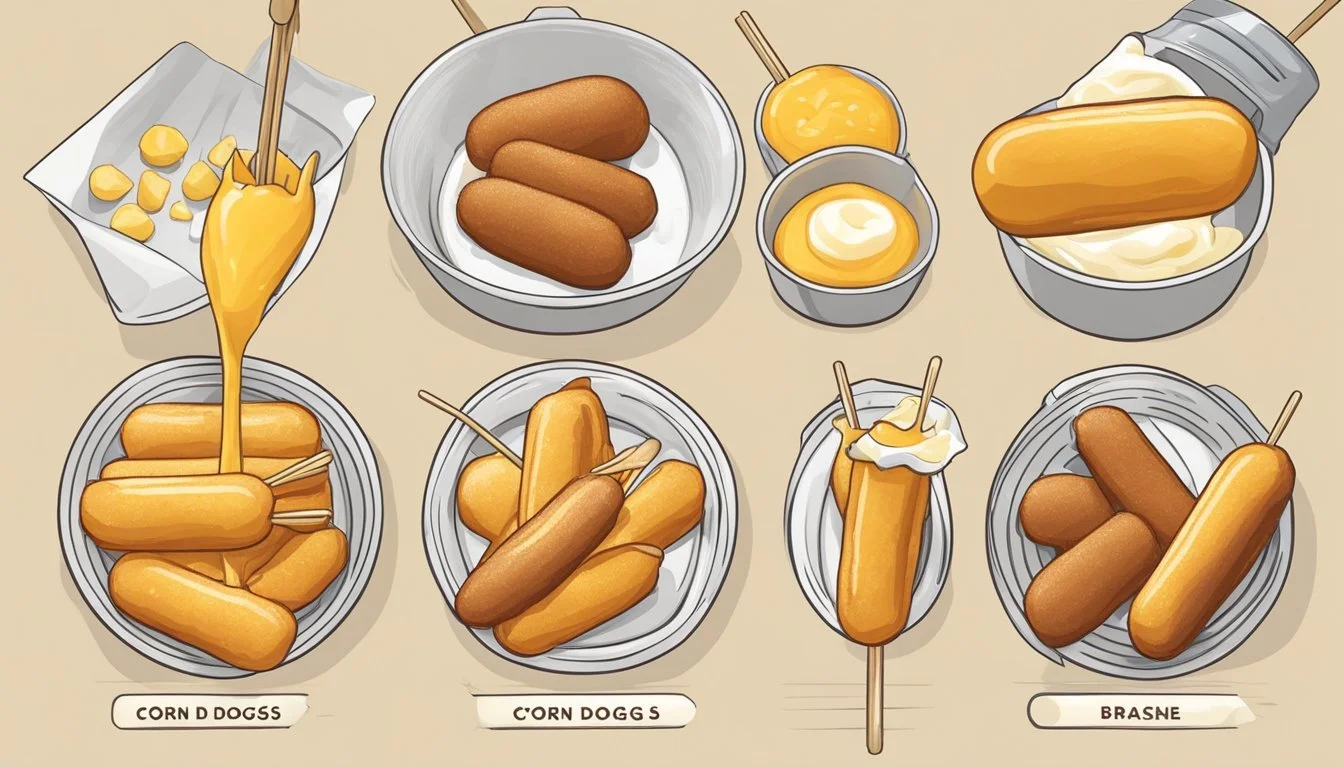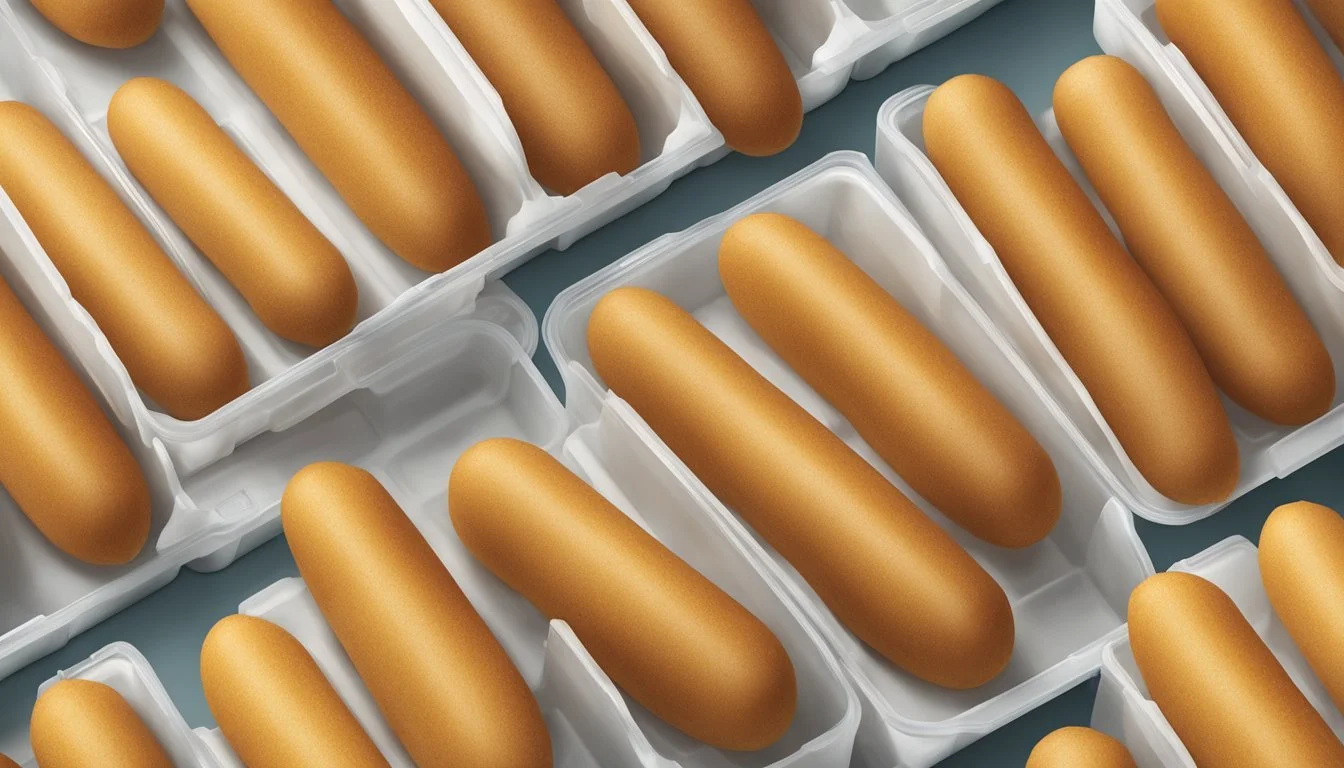How Long Do Corn Dogs Last?
Storage Tips and Shelf Life
Corn dogs, whether store-bought or homemade, are a popular treat enjoyed by many for their crispy, flavorful coating and juicy interior. At fairs and eateries alike, corn dogs are a staple, but how long do they last once you bring them home or make them yourself? Corn dogs can typically last up to 2-3 days in the refrigerator if stored properly.
For longer preservation, freezing corn dogs is a great option. When properly wrapped, they can maintain their quality for about 1-2 months in the freezer. This applies to both homemade and pre-packaged varieties, though homemade versions may have slight variations based on their ingredients and preparation methods.
Understanding the shelf life of corn dogs helps in reducing food waste and enjoying their savory taste for as long as possible. Regularly checking for signs of spoilage and following proper storage practices ensures that your favorite fair snack remains safe and delicious.
Understanding Corn Dogs
Corn dogs are a popular snack consisting of a hot dog or sausage coated in a thick layer of cornmeal batter and deep-fried to golden perfection.
The main ingredients include hot dogs or sausages, cornmeal, and a specific corn dog batter recipe. The batter typically combines cornmeal, flour, sugar, baking powder, and milk or buttermilk.
Ingredients
Hot Dogs or Sausages: The central component, often a beef or pork hot dog.
Cornmeal: Provides the distinctive flavor and texture.
Corn Dog Batter: A mix of cornmeal and other ingredients forming the coating.
Preparation Steps
Skewering: Insert sticks into the hot dogs or sausages.
Dipping: Coat the skewered items in cornmeal batter.
Deep-Frying: Fry in hot oil until golden brown.
This combination makes corn dogs a convenient and delicious snack enjoyed by many.
Ingredients for Corn Dogs
Creating delicious homemade corn dogs involves preparing the right blend of ingredients for the batter and enhancing the flavor with additional elements.
The Basics of Corn Dog Batter
Making the perfect corn dog batter requires a combination of dry and wet ingredients. All-purpose flour and cornmeal form the base, providing the necessary structure and texture. A bit of salt and baking powder ensures the batter is well-seasoned and light.
For sweetness, adding sugar or a touch of honey can balance the savory flavors. Milk or buttermilk helps achieve a smooth, cohesive mixture. Don't forget to include an egg, which binds the ingredients and adds richness to the batter. Ensuring these basics are well-mixed creates a batter that coats the hot dogs evenly and fries up to a crisp, golden perfection.
Additional Flavor Enhancers
Enhancing the flavor profile of corn dogs can be done with several optional ingredients. Adding grated cheese into the batter can provide a delightful, melty surprise inside each bite. For a bit of heat, finely chopped jalapeños can be mixed into the batter, giving the corn dogs a spicy kick.
If you prefer a hint of peppery note, a dash of black pepper can be incorporated. These additional ingredients allow you to customize the flavor of your corn dogs, catering to personal preferences and making them uniquely yours.
Preparing and Cooking Corn Dogs
Corn dogs can be enjoyed by preparing a flavorful batter, choosing the right frying technique, or using alternative methods such as baking or using an air fryer. Each method ensures a delicious result with varying cook times and textures.
Creating the Batter
To create a classic corn dog batter, you will need cornmeal, flour, baking powder, salt, milk, and an egg. Combine the dry ingredients in a bowl. In a separate bowl, whisk together the milk and egg. Gradually add the dry mixture to the wet mixture, ensuring a smooth batter without lumps. The consistency should be thick enough to coat the hot dog evenly.
Using a deep, narrow container for the batter makes dipping the hot dogs easier.
Frying Technique
For a crispy, golden result, deep frying is the traditional method. Heat vegetable oil, canola oil, or peanut oil in a deep fryer or large pot to 350°F (175°C). Skewer the hot dogs on wooden sticks, dip them into the batter, and then carefully lower them into the hot oil.
Fry each corn dog for about 3-4 minutes until they are golden brown and crispy. Remove them from the oil with tongs and place them on a paper towel to drain excess oil.
Alternative Cooking Methods
For a healthier option, baking in the oven or using an air fryer can be excellent alternatives. Preheat the oven to 400°F (200°C) and place the battered corn dogs on a greased baking sheet. Bake for 15-20 minutes, turning halfway through, until they are golden and cooked through.
In an air fryer, preheat to 375°F (190°C), and cook the corn dogs for about 10-12 minutes, ensuring an even, crispy exterior. It’s worth noting that microwave cooking is not recommended for corn dogs as it can lead to a soggy texture.
Storing Corn Dogs
Proper storage of corn dogs helps maintain their quality and extends their shelf life. This section covers key practices for refrigerating and freezing corn dogs.
Refrigerating Corn Dogs
Corn dogs can be kept in the refrigerator if they will be consumed within a few days. After cooking or bringing them home from the store, wrap them tightly in aluminum foil or place them in an airtight container. Refrigerated corn dogs typically last 3-4 days.
Best practices:
Store in the main compartment to avoid temperature fluctuations.
Avoid placing them in the door compartment.
When reheating, corn dogs can be microwaved for 30-60 seconds or baked in an oven preheated to 375°F for 8-10 minutes.
Freezing and Reheating Corn Dogs
Corn dogs can be frozen to extend their shelf life. Prior to freezing, wrap them individually in plastic wrap or aluminum foil, and then place them in a freezer bag. This packaging method prevents freezer burn.
Freezing guide:
Frozen corn dogs last for up to 2 months.
Clearly label with the date of freezing.
For reheating frozen corn dogs, preheat the oven to 375°F. Place the frozen corn dogs on a baking sheet, and bake for 18-20 minutes. If using a microwave, heat on high power for 60-90 seconds, based on your microwave's power settings.
Thawed corn dogs can be treated similar to refrigerated ones and reheated accordingly.
Remember, proper storage and reheating methods ensure that your corn dogs remain tasty and safe to eat.
Serving and Presentation
Proper serving and presentation of corn dogs enhance the eating experience by highlighting the delicious taste and crispy texture. Consider the size and arrangement of the corn dogs and the assortment of condiments and dipping sauces to accompany them.
Dipping Sauces and Condiments
Corn dogs pair well with a variety of dipping sauces and condiments, adding to their flavor profile. Traditional choices include ketchup and mustard, offering a blend of tangy and rich tastes.
For a more gourmet touch, try presenting the corn dogs with sauces such as honey mustard, barbecue sauce, or spicy sriracha mayo.
Set up a dipping station with small bowls containing each sauce. Arrange the corn dogs on a platter, using tall, sturdy sticks to make them easy to pick up. Provide paper towels for cleanliness and convenience.
Food Safety and Best Practices
When handling and storing corn dogs, it is crucial to follow food safety guidelines to prevent foodborne illnesses. Key considerations include understanding the safe handling procedures and identifying signs of spoilage.
Understanding Safe Handling
Corn dogs should not be left outside for more than 2 hours. This timeframe applies to room temperature conditions; beyond this, bacterial growth can occur, leading to potential foodborne illnesses.
Refrigeration: Once cooked, corn dogs can be stored in the refrigerator for 1-2 days.
Freezing: For longer storage, corn dogs can be frozen for 2-3 months. Make sure to store them in airtight containers or heavy-duty freezer bags to maintain quality.
Thawing: Thaw frozen corn dogs in the refrigerator and not at room temperature. This helps in preventing bacterial growth.
Reheating: When reheating, ensure the internal temperature reaches 165°F (74°C) to ensure safety.
Identifying Spoilage
Always check for signs of spoilage before consuming corn dogs.
Visual Inspection: Look for discoloration or mold on the coating or the meat.
Smell: A sour or off smell indicates spoilage. Fresh corn dogs should have a savory, appealing smell.
Texture: If the corn dog feels slimy or sticky, it is likely spoiled.
Taste: Any unusual or bad taste means the corn dog should be discarded. Fresh corn dogs should taste slightly sweet from the cornmeal and savory from the hot dog.
These practices are essential to ensure that corn dogs remain safe and enjoyable to eat.
Dietary Considerations and Substitutions
When making or buying corn dogs, it's important to consider dietary restrictions and preferences. Various substitutions can be made to accommodate gluten-free, dairy-free, vegetarian, and vegan diets without compromising on taste.
Gluten-Free and Dairy-Free Options
For those with gluten sensitivities, corn dogs can be made using gluten-free flour instead of traditional flour. Opt for all-purpose gluten-free flour blends that combine rice flour, tapioca starch, and potato starch.
Milk can be replaced with plant-based alternatives such as almond milk or soy milk to make the batter dairy-free. Ensuring the batter does not contain any hidden dairy ingredients is crucial.
When it comes to frying, vegetable oil is a safe choice for both gluten-free and dairy-free cooking. This helps maintain the classic taste while catering to dietary needs.
Vegetarian and Vegan Variations
Vegetarian corn dogs can be made using plant-based sausages as a substitute for meat. Many brands offer soy-based or seitan sausages that retain the texture and flavor expected in a traditional corn dog.
For vegan options, eggs in the batter can be replaced with a flaxseed or chia seed mixture. Combine one tablespoon of ground flaxseed or chia seed with three tablespoons of water to replace each egg required in the recipe.
Using a vegan-friendly milk like oat milk and ensuring no animal-derived ingredients are used can make the batter vegan. Additionally, frying in vegetable oil ensures it suits both vegetarians and vegans.
Exploring the Cultural Significance of Corn Dogs
Corn dogs hold a special place in American culture. Their origins trace back to state fairs, where they became a staple and added a sense of nostalgia to these gatherings. The combination of tender pork franks encased in a crispy cornmeal batter provides a unique culinary experience.
They are a popular form of street food, often enjoyed at carnivals and amusement parks. This accessibility has made corn dogs a symbol of simple pleasures and shared experiences.
Fair vendors introduced various versions, such as the "footlong corndog" and "jumbo corndog," adding to the snack's popularity. These variations contributed to its enduring presence in American food culture.
The corn dog's appeal lies in its portability and ease of consumption. People appreciate the convenience of walking around a fair or park while enjoying a freshly fried corn dog. This has cemented its place as a beloved snack across different states and generations.
Corn dogs evoke memories for many, serving as a reminder of festive occasions and family outings. These associations have turned the corn dog into more than just food—it is a cultural icon representing joy and togetherness.









